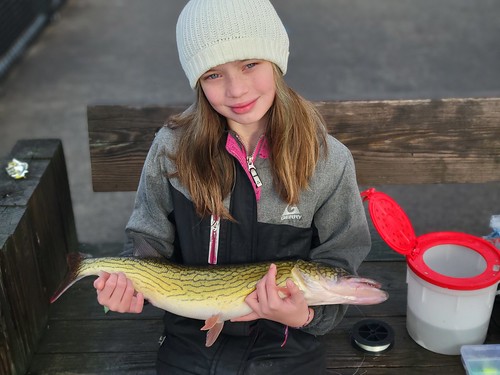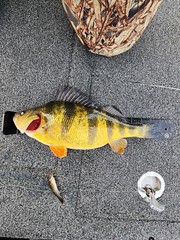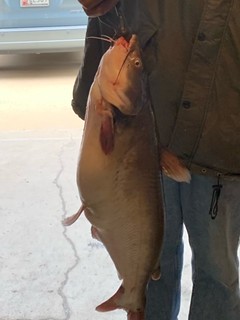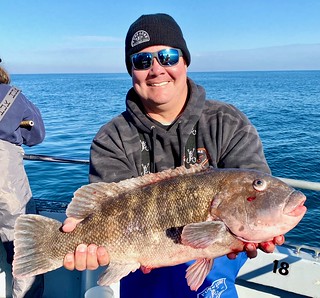Maryland Fishing Report – Late Winter

Young angler Lucy Perez kicked off 2023 with her first chain pickerel caught at Loch Raven Reservoir. Photo by Nick Perez
Some may believe February is a month for indoor activities, but there is plenty of winter fishing to be enjoyed. There are excellent opportunities for large tautog off Ocean City, fishing for many freshwater species is good, and Maryland Department of Natural Resources crews are placing generous amounts of trout in put-and-take waters near you – check the DNR trout stocking website. With some mild weather in the forecast, gather up some young people to enjoy some outdoor fun.
Several of the 2023 Maryland Chesapeake Bay and Atlantic Ocean finfish seasons and regulations have been posted on the DNR website, including the 2023 Maryland recreational striped bass regulations.
Also, Maryland’s 2023 recreational bluefish regulations are the same as last year, with an 8-inch minimum size and catch limits of three bluefish per day for individual anglers and five per day for anglers on for-hire boats. The summer flounder regulations for 2023 will be a maximum of four per day with a 16-inch minimum size. The 2023 recreational cobia season will be open June 15 through September 15, with limits of one cobia per angler or two cobia per vessel with more than two anglers onboard, and a minimum size of 40 inches.
In the Atlantic Ocean, the tautog season is currently open through May 15 with a limit of four fish per day; the season reopens July 1 through October 31 with a daily limit of two fish per day, changing to a daily limit of four fish per day from November 1 through December 31. The minimum size for tautog during all seasons is 16 inches.
The Atlantic mackerel, also known as a Boston mackerel, has a recreational limit of 20 fish per angler. The scup, also known as porgy, is open to fishing year-round with a recreational minimum size of 9 inches and a 50 fish-per-day creel limit. The black sea bass season is closed from January 1 through May 14, and additional regulations are to be determined by the Atlantic States Marine Fisheries Commission and the Mid-Atlantic Fishery Management Council.
All seasons and regulations for every species of fish in Maryland can be found in the new Maryland Guide to Fishing and Crabbing.
Look for the weekly Maryland Fishing Report to resume in March.
Forecast Summary: February 2023:
With Bay and river temperatures at the low 40s, Bay fish are at their winter holding areas. With plenty of cool waters and oxygen from surface to bottom, look for concentrations of fish in some of the remaining warm water areas. In the Bay mainstem, warmer bottom waters – below 50 feet – are located from about Hart Miller Island south to near Bloody Point in areas with good structure and protection from strong current such as underwater points, channel edges, and bridge pilings with nearby oyster bottom and reefs. The other warm water areas to consider are near the water discharges of your local power plants.
We will begin our weekly Bay fishing conditions forecasts again in March. However, for those hearty cold water anglers, all water conditions maps, plots and satellite pics will be continuously updated and posted. So for detailed and up-to-date fishing conditions in your area of the bay, continue to check out Click before You Cast.
Stay tuned, Click Before You Cast will be adding lots of new features this season to help you catch more fish. As always, drop us a line with comments or suggestions.
Blue catfish, channel catfish, and yellow perch are providing most of the fishing action in the upper Bay. Blue catfish can be found holding in the deep channels of the region’s tidal rivers. The deep hole just below the Susquehanna River railroad bridge is a very good spot to fish for blue catfish when the weather permits. A variety of baits are often used by anglers including cut menhaden and gizzard shad, and chicken liver and breast meat. The use of scents to enhance baits and chumming are also popular with blue catfish anglers.
Anglers have been looking for yellow perch for a couple of weeks now and finding some in the deeper waters of the tidal rivers. The same deep hole in the lower Susquehanna River where the blue catfish are holding is also attractive to yellow perch. Unfortunately blue catfish larger than 10 pounds have no problem eating the sluggish yellow perch, adding some competition for anglers. In the extreme deep waters of the lower Susquehanna, a bottom rig baited with small minnows with heavy sinkers of 2 – 3 ounces will get down to the fish.
In the tidal rivers of the upper Bay, yellow perch will be found for the next month holding in holes 15 feet or deeper. As February progresses, more yellow perch will be found in these deeper channel areas in the middle to upper sections of the spawning rivers, waiting for warmer water temperatures. The yellow perch will be sluggish so pickups of bait will be slight. A small lip-hooked minnow with a split shot placed about two feet ahead of the minnow and worked very slowly across the bottom is a good tactic. Small marabou jigs, the smallest you can find, can be worked under a slip bobber. Once you can determine the depth, the jig must be very close to the bottom.
Most fishing action in the middle Bay, as with the upper Bay, is blue catfish, channel catfish, and yellow perch. The Choptank River holds the largest concentrations of blue catfish right now, and they can be found in the middle sections of the river in the deep channel areas. Channel catfish are also active in these same areas and can provide plenty of fishing fun. Both species of catfish can be found in all the region’s tidal rivers.
Yellow perch are slowly moving up the spawning rivers this month. They will be staging in deep pools and channels until the water temperatures are warm enough for them to move into the upper spawning areas. Small lip-hooked minnows behind a split shot that is worked slow and close to the bottom can entice them to pick up a snack. Some anglers are also reporting good luck working very small ice-fishing jigs tipped with a piece of minnow close to the bottom in the deeper holes. If you are interested in catching your own minnows, learn some tips in Angler’s Log on the DNR website.
Calm and warm days this month will most likely bring out a few catch-and-release anglers looking for striped bass. Water temperatures are in the low 40s so it will be hard to find striped bass willing to take a jig. The warm water discharge at the Calvert Cliffs Power Plant will most likely be your best bet to drift and jig.
Fishing for blue catfish is perhaps one of the more popular and successful fishing endeavors this month in the deep channel areas of the Nanticoke, Patuxent, and Potomac rivers. The catfish have moved to the middle sections of the tidal rivers and are holding deep in the channels. A variety of cut baits work well, with menhaden and gizzard shad at the top of the list. Those who are seeking trophy-sized blue catfish often fish around the Fort Washington area with live bait in the form of bluegill sunfish or large goldfish called Black Salties. Generally, blue catfish weighing less than 15 pounds offer the best table fare. Chicken livers, chicken breast, and scented baits also work well on blue catfish that size.
Anglers will find some yellow perch in the deeper pools in the staging areas below the spawning reaches and they can be caught on small lip-hooked minnows and jigs worked close to the bottom. Some of the tidal tributaries to the Potomac River are a good place to look, as is the upper Patuxent.
Freshwater put-and-take anglers will focus much of their attention on the trout management waters that are receiving preseason stockings this month. The trout management ponds, rivers, and creeks are cold enough for the trout to thrive, and they offer weeks of good fishing after each stocking. The latest activities can be found on the DNR trout stocking webpage and anglers can sign up to get email notifications when locations are stocked.
Anglers are bundling up in warm clothes and fishing the upper Potomac for a mix of walleye, muskellunge, and smallmouth bass this month. You can target walleyes and smallmouth bass by working small jigs close to the bottom in deep pools, current breaks, and eddy edges.
Chain pickerel are providing plenty of fun cold-water fishing opportunities in both non-tidal and tidal waters this month. Medium-sized chain pickerel can be found holding along shorelines, often near sunken wood. The trophy-sized chain pickerel are often in deeper waters and holding near any kind of structure they can find. Single-hook lures offer an advantage of easy unhooking, causing less damage to the pickerel’s gills since they often inhale lures.
Conditions are not good for ice fishing at Deep Creek Lake and other lakes and reservoirs. There were recent reports of anglers who fell through thin ice in a few selected coves at Deep Creek Lake – fortunately, there was no loss of life. The Maryland Natural Resources Police offer ice fishing safety rules on the DNR website.
Fishing for large tautog could hardly be better this month at the wreck and reef sites offshore of Ocean City. Anglers have experienced calm seas and sunny skies on many of the trips. The tautog season will remain open with a limit of four fish per person each day until May 15; the season reopens July 1 through October 31 with a daily limit of two fish per day, changing to a daily limit of four fish per day from November 1 through December 31. The minimum size for tautog during all seasons is 16 inches.
“The chief difference between big-game fishing and weightlifting is that weightlifters never clutter up their library walls with stuffed barbells.” – Ed Zern
Maryland Fishing Report is written and compiled by Keith Lockwood, fisheries biologist with the Maryland Department of Natural Resources.
Click Before You Cast is written by Tidewater Ecosystem Assessment Director Tom Parham.
This report is now available on your Amazon Echo device — just ask Alexa to “open Maryland Fishing Report.”




